A “new normal.” What does it look like? Are we there yet? Will we know it when we arrive? Over the past few years, we have all been wondering about what a “new normal” would look like, particularly from a work perspective. There are many organizations that have successfully adjusted and thrived in their version of a “new normal.” Likewise, there are organizations that remain lost, and undeniably, there is a substantial percentage of companies that are still finding their path. What we have come to understand with certainty is that the “new normal” looks different for everyone and every organization. That said, one fundamental goal that should unite the efforts of organizations across the globe is to continue fostering a culture that engages, motivates, inspires, and retains their most important asset—their people.
Leaders have eagerly awaited to see what would happen to engagement levels after observing a massive spike in engagement during 2020, followed by a subsequent roller coaster decline during 2021. The question became whether engagement would continue to fall or whether it would stabilize as this “new normal” becomes established. And perhaps more importantly, what are likely key levers that managers and leaders can pull in order to optimally engage their workforce and drive organizational performance within the current landscape?
Workforce Science Associates (WSA) has continued to curate one of the most comprehensive databases of employee research in the world (WSAdata). During the past three years, WSA has administered 586 census survey projects, capturing 153 million survey responses across 151 countries around the globe. Each year, we continue to add tens of millions of individual responses to this three-year rolling database. WSA has leveraged this data to analyze the most recent engagement trends as well as identify the most relevant factors that are driving engagement—these key drivers motivate your workforce to want to work harder, stay longer, and most importantly care more for your customers.
We have heard the story of how engagement declined in 2021, as this was both predictable and inevitable based on the anomaly year that was 2020. Some may have interpreted the decline in 2021 as a negative sign; however, after integrating what we know from 2022 engagement data we find that engagement trends were merely adjusting to the “new normal.” From an engagement perspective, this means regressing back to pre-pandemic levels.
Just as employee engagement had been quite stable between the years of 2015 and 2019, we are seeing a similar pattern emerge in 2021 and 2022. Engagement, while increasing ever so slightly, has held relatively steady. When reviewing bi-annually, we found that engagement hit its lowest level in the second half of 2021 after declining from the peak experienced in the second half of 2020. Since bottoming out in the second half of 2021, engagement has increased slightly and appears to have stabilized within pre-pandemic levels. While many organizations have improved during 2022, 2023 brings new uncertainty which will be closely monitored as credible sources tout an impending recession and many large brands have been in lock-step announcing workforce reductions to right their ships. Further research is being done regarding the Manager Effectiveness trend which will be included in a larger study that will focus solely on Manager Effectiveness, and it will be released later this year.
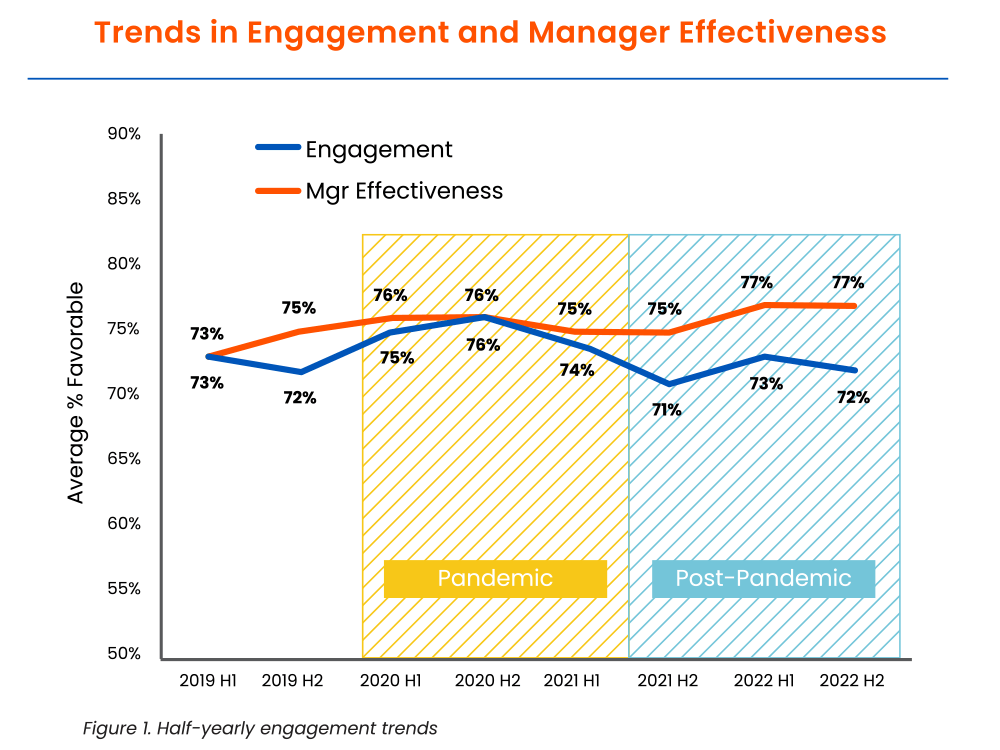
We were also curious if the pre-, during, and post-pandemic engagement trend had any differences when looking at the identity groups of race and gender. Our analysis revealed that, in general, employees of different races demonstrated a similar engagement trend. However, there were some noteworthy differences (Figure 2). For instance, employees who identified as two or more races showed a negligible increase in engagement during the midst of the pandemic, but experienced a steeper decline post-pandemic, dropping 4.4 percentage points as compared to 2019 levels. White employees also experienced a decline in engagement levels, with a 2 percentage point drop from 2019.
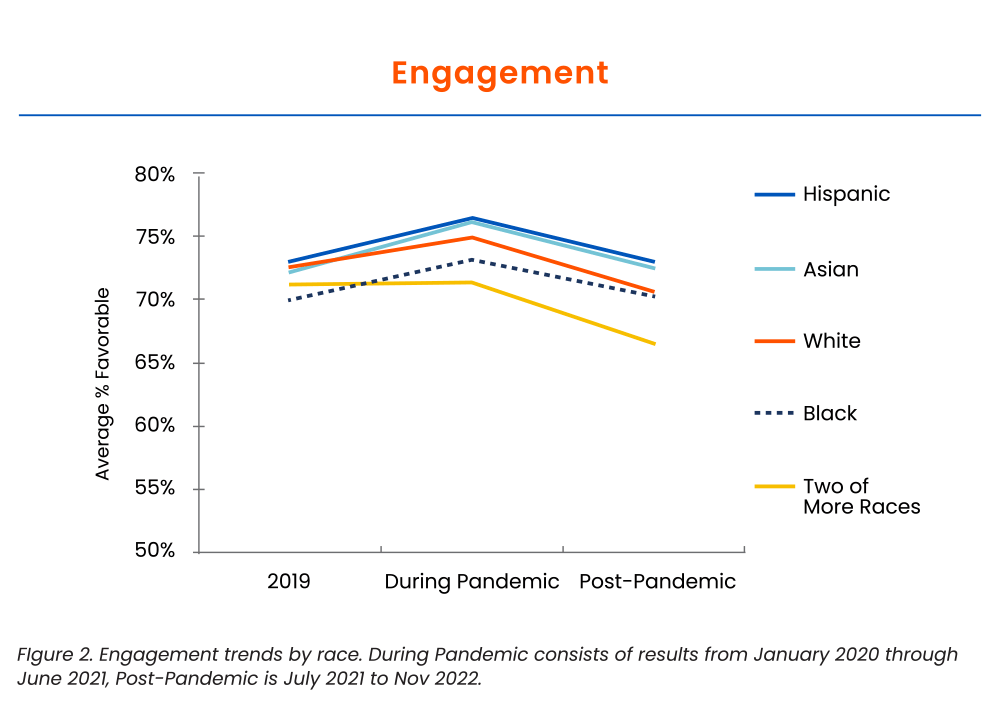
When we examined engagement levels by layering gender and race, we discovered additional compelling results. WSAdata showed that Black women, while still having the lowest engagement scores, had the biggest improvement of all groups, with a 1.3 point increase since 2019 (Figure 3). This progress is especially noteworthy given the historical disenfranchisement of this group. On the other hand, White women experienced a 2.3 point drop in engagement levels, and White men and men identifying as two or more races experienced respective drops of 1.2 and 3.4 points (Figure 4).
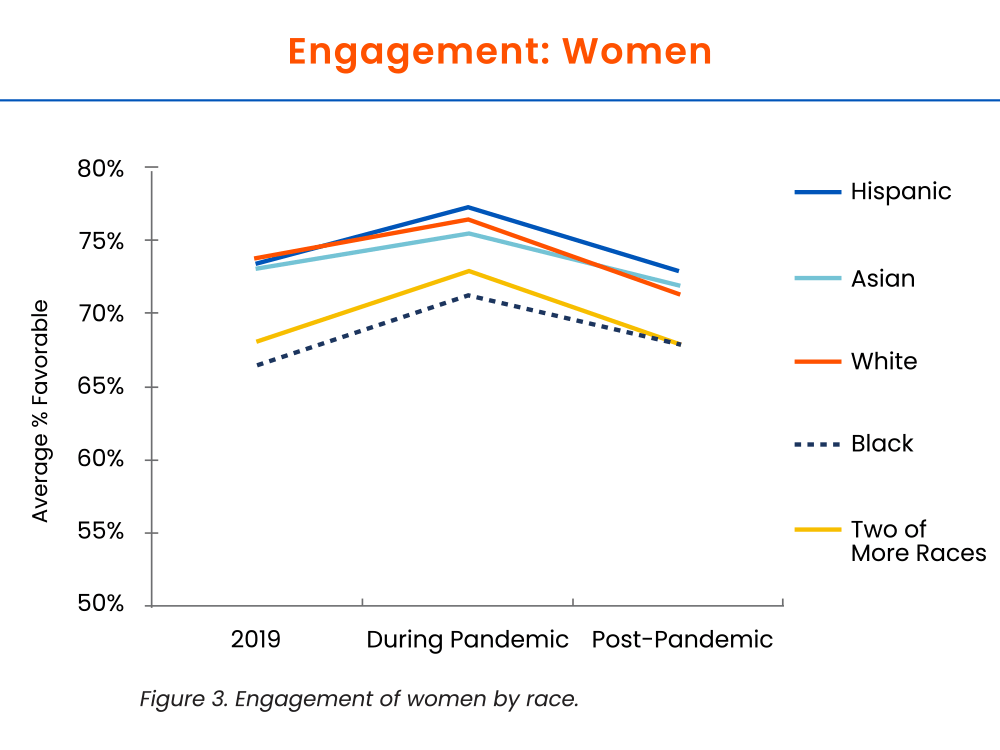
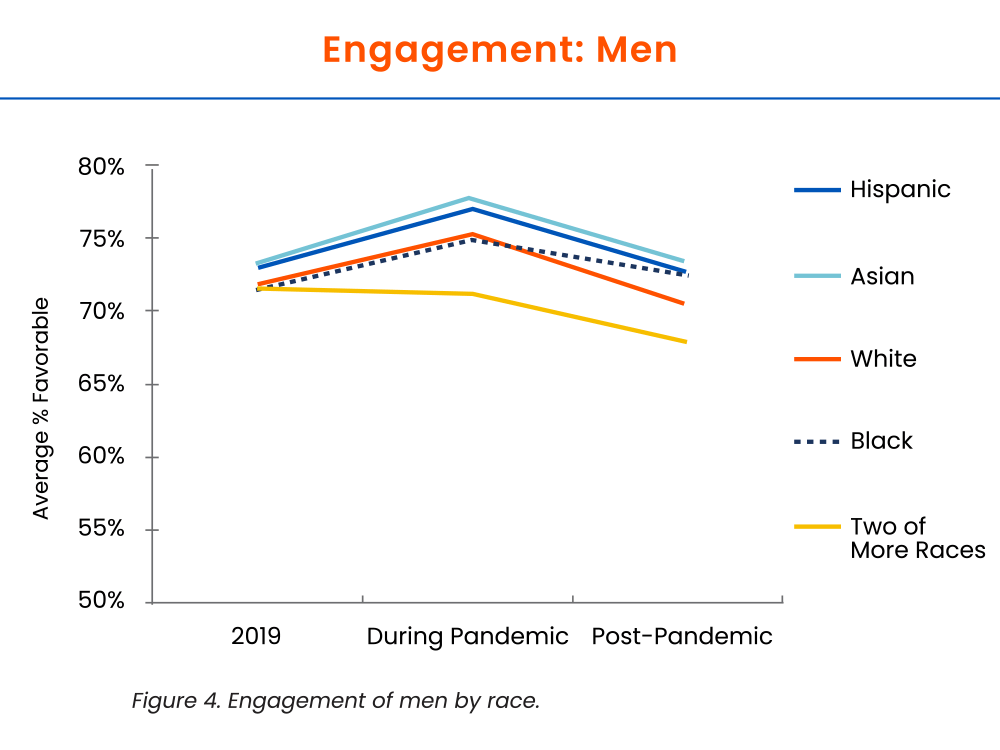
When looking at engagement by management level and gender, we found that the trends are consistent across these groups, with an increase during the pandemic and a decrease back to 2019 levels post-pandemic (see appendix for Figures 8-10). However, we discovered one exception at the most senior level (defined as Executive Vice President and above) (Figure 5). WSAdata showed that engagement scores for male senior leaders have continued to increase since 2019, while women at this level have continued to decline during that same timeframe, with a significant decline since the pandemic resulting in an increase in the gap between these genders post-pandemic. Upon closer inspection, we found the source of this engagement decline for women leaders, specifically those who have been with their organization for 2-10 years, was due to the predominant decline in the commitment to stay item: I rarely think about looking for a new job with another company. In contrast, new and legacy women leaders are not experiencing this same drastic decline, and this decline was not present during or before the pandemic.
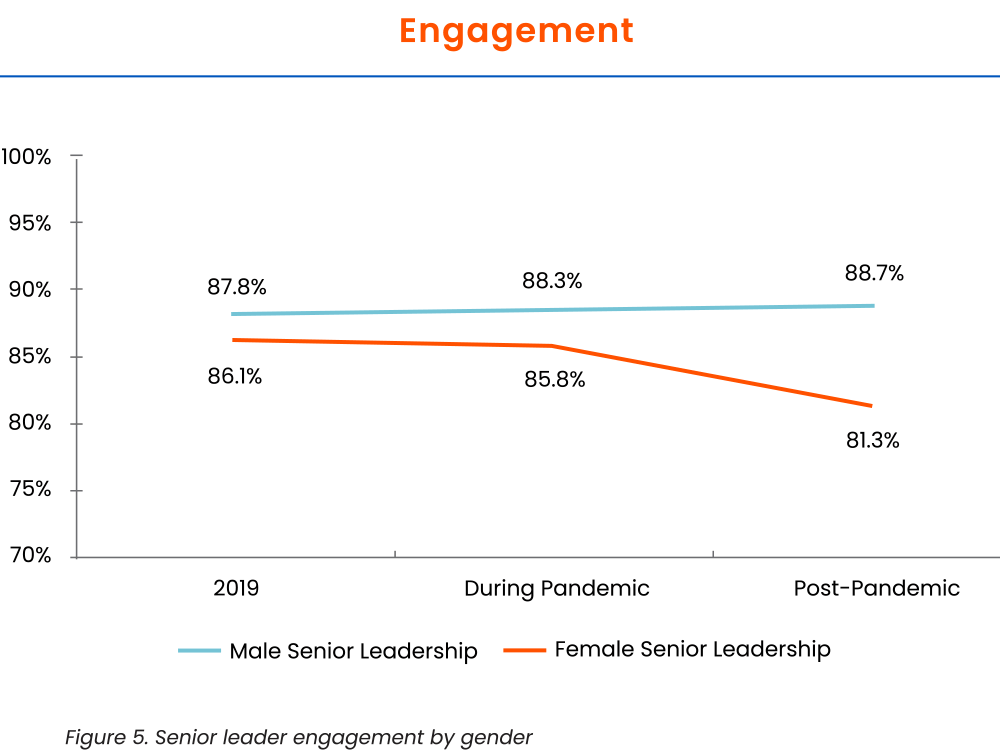
Curious about what is driving this change in commitment for women leaders, we investigated a few hypotheses. Our analysis revealed that women senior leaders scored significantly below their male counterparts on work/life balance, and interestingly, this pattern was also found pre-pandemic. Diving deeper to see if diversity, equity and inclusion (DEI) were a part of the issue, we found that there were significant increases in scores for women senior leaders regarding their organization’s commitment to diversity and inclusion. However, when we examined the top drivers of engagement, we found that the scores for the majority of the top drivers decreased after the pandemic for women senior leaders, while all of these items increased for male senior leaders. The themes that rose to the top as drivers are associated with recognition, future vision, and leadership trust. The top driver of engagement for women senior leaders is, This company values my contribution. Post-pandemic, women leaders were significantly lower on this particular item compared to their male counterparts. Knowing this, it is critical that senior leaders reflect on new ways of working to ensure that everyone, especially women leaders, feel recognized and valued for their contributions and hard work. WSA will be releasing a more detailed analysis of the trends we are seeing across women leaders later this year.
Regardless of the times and the economic conditions, our decades of research has consistently shown that there are fundamental drivers of engagement that generally show up regardless of organization size, industry, or country/culture. These fundamental drivers of engagement continue to be the foundational tenets of the employee-employer relationship. While a comprehensive description of these aspects is beyond this work’s scope, we know that the relative importance and nuances of these drivers are what tend to shift over time based on the prevailing environment. A particular pattern we have observed time and again is the shift in order of priority for key drivers during more or less turbulent and uncertain times.
While current global conditions would certainly not be described as “easy,” “ideal,” or perhaps even “prosperous,” it is safe to say we are not in the same “crisis mode” as we were just a few short years ago.
Just as key drivers in the recent past were identified as being consistent with what we tend to see during times of crisis, WSA hypothesized that key drivers of engagement post-pandemic are likely to be more reflective of what they were prior to the onset of the pandemic—the key drivers that focus more on the “self” when it comes to those aspects that make us more motivated, conscientious and committed. Employees want to see, know and consistently feel “what is in it for me” as they put forth their efforts day in day out.
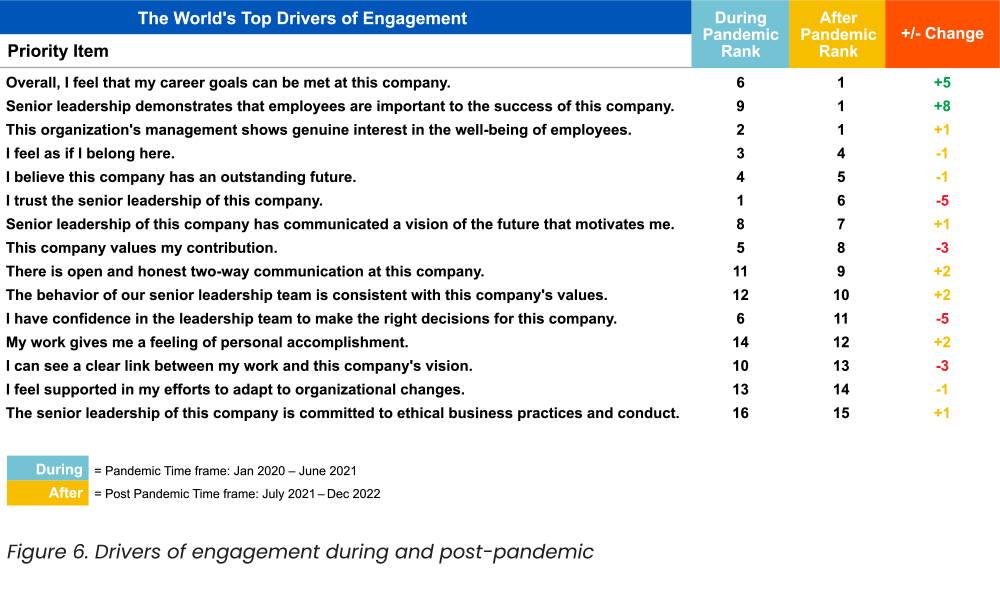 Figure 6 shows the current top drivers of engagement now, post-pandemic, compared to what they were during the pandemic. While most items are included in both lists, we can see that the priority order has shifted in terms of what is most important to employees. Currently, employees feeling that their career goals can be met, being shown by senior leaders that they are important to the company’s success, and that their well-being is a focus of leaders are the predominant factors influencing engagement. Senior leadership demonstrating that employees are important to the success of the company went from the ninth-ranked key driver to being tied for first—an item directly linked to how valued an employee feels. Overall, I feel that my career goals can be met at this company increased from the sixth-ranked driver to also being tied for first, which is another concept focused solely on the “self.”
Figure 6 shows the current top drivers of engagement now, post-pandemic, compared to what they were during the pandemic. While most items are included in both lists, we can see that the priority order has shifted in terms of what is most important to employees. Currently, employees feeling that their career goals can be met, being shown by senior leaders that they are important to the company’s success, and that their well-being is a focus of leaders are the predominant factors influencing engagement. Senior leadership demonstrating that employees are important to the success of the company went from the ninth-ranked key driver to being tied for first—an item directly linked to how valued an employee feels. Overall, I feel that my career goals can be met at this company increased from the sixth-ranked driver to also being tied for first, which is another concept focused solely on the “self.”
Over the past several years, employees have stepped up to the plate and delivered for their organizations in a time of crisis. They were asked to work longer hours and in many cases, carry heavier workloads or do more with less due to some of the highest levels of attrition the workforce has ever experienced. Employees gave organizations their all, and throughout this time, some of the most critical factors driving engagement were about employees’ trust and confidence in senior leaders to successfully navigate the turbulence—concepts more related to the broader organization’s viability than the individual self. While these factors are most certainly still important (especially as people are watching to see how leaders manage workforce reductions), they are not at the very top of the list. As seen in Figure 6, I trust the senior leadership of this company was the top driver of engagement previously, though it is now ranked sixth. Similarly, the item I have confidence in the leadership team to make the right decisions for the company has moved from the rank of number six to now eleventh.
In contrast to engagement levels declining from the peak observed during the pandemic, WSA’s most recent data shown in Figure 1 reveals that managers are actually being perceived more favorably post-pandemic. In today’s workplace environment, the importance of connecting employees to the organization is priority number one for managers. When employees feel like they are part of something larger than themselves and can see themselves having a bright future working for the organization, the manager has been successful in a few key areas:
• Communicating the cause/purpose of the organization in a way that emotionally connects to the employee
• Being respectful to others and treating everyone fairly/equitably
• Understanding the personal skills, talents, and goals of each team member so they can be exposed to work that excites and challenges them
The behaviors and actions driving manager effectiveness have changed very little over the years; it is still about employees perceiving their managers as a trusted advocate who cares for them as a person. Figure 7 represents an overview of the key areas that have the greatest impact on manager effectiveness. With the rise of remote or hybrid working models over the past few years, there has been a decrease in the breadth of opportunities for managers and direct reports to have casual, yet invaluable, interactions that focus on the individual employee. In the current environment, managers need to be more intentional with their behaviors and communication to ensure that employees see a clear path for the future that connects to their individual goals, feel valued for making important contributions to the organization’s success, as well as feel a sense of inclusion and belonging. Bottom line: leaders who put the success of their employees first, including helping employees clearly see “what’s in it for me,” will likely have the greatest success moving forward.
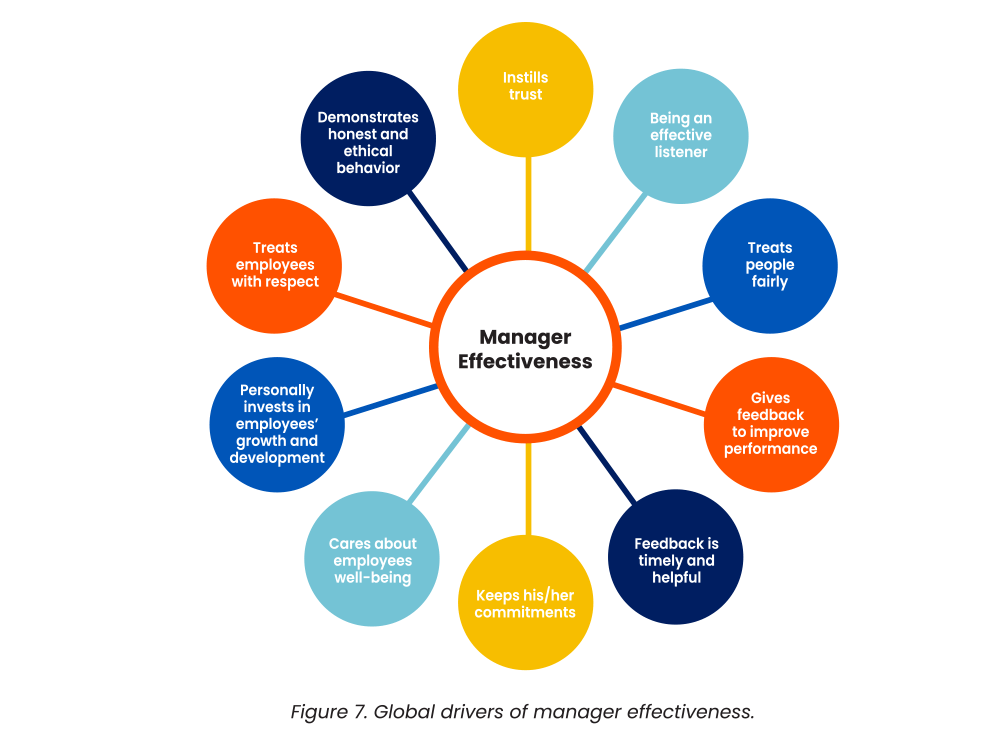
No one would argue that the pandemic has drastically changed the way in which and where people work. This remains a trivial piece of the puzzle that companies are still trying to piece together as they decipher where work can and should happen, and how teams can best collaborate with and support one another.
In a recent study by Gartner (2022), it was reported that 31% of companies set no minimum requirements for days in office/week, while 5% required 5 days/week, 26% required 3 days/week, 17% required 2 days/week, and 4% required 1 day/week. Such data only further illustrates the variance in strategies.
We are often asked by our clients how other companies are approaching the new way of work, particularly those who have been successful in their efforts. While we are aware of the conundrum, and anecdotal client stories do exist, no one has the exact data to show what does and does not work best. And perhaps that will always be the case because a successful future of work strategy looks different for each organization.
A key recommendation for identifying what may work best for your organization is to gain insight directly from your employees. Informing your strategy based on employee feedback is critical to building/maintaining trust, as well as retaining your workforce, particularly your high performers. There are a few factors to consider in doing this correctly. One of those factors is to accurately capture a “work arrangement” demographic within your employee surveys to ensure that you understand the different experiences and needs of your employees based on where work gets done. WSA’s database informs us that organizations are doing this inconsistently. Only 18% of clients within our database capture a “work arrangement” demographic at all, and for those that do, there is quite a variance in the types of arrangements that are identified. WSA recommends going forward to utilize consistent measurement methodology to gain valuable insights that take into account where employees work. That recommendation involves the inclusion of a “work arrangement” demographic to your employee surveys to identify employees in the following categories: Full-time Remote, Hybrid, Full-time In Office.
A second recommendation involves asking the right survey questions with the right intention and frequency. For instance, organizations are hiring in a new landscape and many are looking for talent anywhere, often in novel talent pools. Organizations cannot afford to lose sight of the ways in which they onboard new, remote employees in key roles. From a tactical perspective, organizations need to understand how equipped they are to train and provide resources to those who are remote and may never step foot in a physical office space. Do employees have what they need to perform?
From a psychological perspective, it is key to understand employee needs/desires based on the aforementioned key drivers of engagement. For both new and existing employees, connection and communication are key, and this is likely to look different based on work arrangement. Do employees feel connected with the organization, their team, and their leader? Are employees receiving strong local leadership communications that keep them informed and inspired around the direction they are headed? Do they feel as if their manager understands their individual needs and aspirations? Maintaining a pulse on employee sentiment in this regard is key to informing a future of work strategy that capitalizes on strengths and closes the gap on opportunities that are critical to engaging and equipping your workforce.
While engagement has appeared to stabilize, attitudes of employees toward work and their role within organizations have shifted. After examining the key drivers of engagement, both during and post-pandemic, the story is quite clear—employees are ready to shift the focus back to themselves. They want to feel valued and cared for, vividly sense that they are an important part of the company, as well as see a clear path where their career goals can be realized. As employees have always and still need to be inspired by a compelling future vision, that vision must be clearly linked to “what’s in it for me.”
We also know that women senior leader engagement has declined since the pandemic, widening the gap between their engagement and that of their male counterparts. Notably, women senior leaders are considering leaving their organizations at a much higher rate than male senior leaders. Therefore, retention and new ways of working strategies must include a focus on this critical group.
Lastly, front-line managers are going to be key in the “new normal,” as they are the closest link to employees within organizations. Managers carry with them an important responsibility of helping employees adapt to the new way of working within their own organization. They are also the individuals who can bring the greatest level of personalization to the employee experience—through regular career conversations that focus on individualized goals and consistent, meaningful individualized recognition. Managers are also given the regular opportunity to demonstrate care for employees, translating people-focused principles and values derived by senior leadership onto employees every single day. With the renewed focus on “self” when it comes to employee engagement, as well as the need for helping employees thrive in the new way of work, there has never been a more important time to ensure the most effective managers are in place to play this pivotal role.
Authors and Content Contributors:
Sheena Lyons, M.S., Executive Consultant, WSA
James Longabaugh, Ph. D., Director of Consulting, WSA
Robert Weldon, Ph. D., Director of WSAdata, WSA
Randy Sterns, M.B.A., Executive Consultant, WSA
Ellie Erickson, M.B.A., Executive Consultant, WSA
Bob Bergman, Ph.D., Executive Consultant WSA
Kris Erickson, Co-Founder and Executive Consultant, WSA
Download the PDF for references.
Download PDF